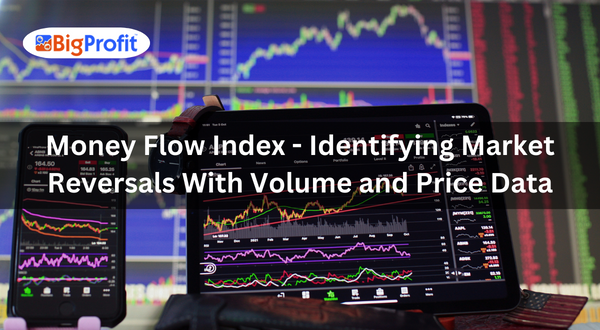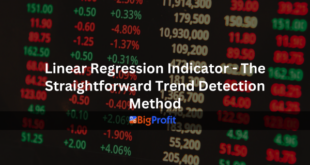MFI differs from other technical indicators like RSI by taking both price and volume into account, providing overbought/oversold signals as well as any divergences from price that might indicate trend reversals.
As shown below in a four-hour chart of GBP/USD, MFI had reached an oversold condition before price crossed over a 20 exponential moving average.
Overbought
The Money Flow Index (MFI) is a technical indicator that uses both price and volume data to generate overbought/oversold signals. Unlike traditional oscillators such as Relative Strength Index (RSI), MFI incorporates volume information that makes it more sensitive to changes in market momentum than its RSI counterpart, helping traders identify overbought markets more quickly while also helping identify divergences that signal potential shifts in trend direction.
Calculating MFI involves multiplying a period’s typical price with its trading volume to obtain raw money flow, which is then divided by total number of periods to give us its value for each individual period. Positive money flow indicates instances when typical prices exceed previous ones while negative money flow indicates any time where typical prices decline below previous ones.
Once the MFI reaches overbought levels, it could signal that prices could experience a potential reverse trend; however, it should be remembered that such a reversal isn’t always imminent when MFI reaches either overbought or oversold levels.
Traders can combine the MFI with other indicators to make informed trading decisions. For instance, the Relative Strength Index (RSI) often moves in tandem with the MFI and can provide confirmation that price trends have changed. Other tools like on-balance volume analysis, moving average convergence/divergence analysis and Aroon indicators may also be helpful when trying to identify opportunities.
While the MFI can provide reliable signals during strong trends, its signals may still prove misleading; to help prevent any such miscalculations it should be used alongside other technical indicators like the RSI and MACD as well as having an effective risk management plan in place to minimize losses while protecting profits.
Oversold
Money flow index (MFI) is an oscillator-type indicator that uses both price and volume data to provide overbought/oversold signals. Similar indicators include Relative Strength Index (RSI), Moving Average Convergence Divergence, on-balance volume, Aroon indicator and stochastic oscillator. When MFI reaches an overbought/oversold level, traders may choose to open trades but must confirm trend reversals via further technical analysis before entering new trades; moving averages can help keep them on the right side of the market.
The MFI can be an excellent tool for identifying oversold markets, but it may produce false trading signals. To combat this issue, traders should combine the MFI with other indicators capable of detecting price reversals as part of their trading strategy – for instance if MFI reaches an oversold level, traders should watch for bullish divergences from price, which indicates an increase in prices soon thereafter.
Oversold conditions tend to appear below 20 and overbought levels typically reach 80 on the MFI; these thresholds are based on historical readings for each period – higher MFI readings indicate increased buying activity while lower readings may signal selling activity.
MFI is an increasingly popular momentum indicator used to detect potential reversals in highly trending markets. Unfortunately, however, MFI may produce false signals at times due to overly volatile markets; as a way around this issue traders should use a moving average filtering out false signals for more accurate readings.
MFI readings not only indicate overbought and oversold conditions in a market but can also signal market reversals by showing divergences or failure swings. Traders can look out for these signals by analyzing an asset chart and searching for instances when MFI divergences differ from price changes; an example would be when its price makes new highs while its MFI remains below overbought threshold: this may indicate selling pressure ahead.
Divergences
The Money Flow Index (MFI) is a leading indicator designed to assist traders in detecting market reversals. As with other technical indicators, the Money Flow Index takes into account both price and volume data in its calculations to provide a complete picture of market conditions. Furthermore, unlike many technical indicators, MFI also allows traders to identify divergences when indicator readings begin diverging from underlying price trends – an opportunity used by conservative traders in different trading strategies: they might wait for momentum to cool when momentum reaches an overbought level, or wait for bearish divergence signals before entering.
As traders who rely on the MFI should be mindful that its signals may produce false alarms, it is wise to combine it with other indicators and risk management strategies in order to utilize its full potential. Furthermore, traders should keep in mind that its use does not guarantee a reversal – for instance stocks could continue moving upwards even after reaching an overbought level of 80 or further down even after reaching an oversold level of 20 on MFI’s scale.
To calculate Money Flow Index (MFI), simply sum all positive and negative money flows during a specified timeframe. When security prices rise during this period, their raw money flow adds to Positive Money Flow; when prices decline during this timeframe, its raw money flow adds to Negative Money Flow. MFI calculations can be performed manually or with spreadsheet programs.
MFI indicators provide traders with another useful indicator: failure swings. A failure swing occurs when an indicator makes a higher low and then makes a lower high, suggesting selling pressure is weakening and therefore an upward reversal may soon take place.
Another way to understand the MFI is to compare it with the Relative Strength Index (RSI). While they both share similar settings and functions, each operates in slightly different ways. While the RSI tracks momentum by measuring price movements and changes over time, while MFI also takes transaction volumes changes into account to produce its reading – making the MFI a more leading indicator than RSI.
Reversals
Money Flow Index (MFI) is an indicator that measures the ratio between positive and negative money flow, from 0 to 100. It can be used to spot overbought and oversold conditions as well as any divergences between its readings and prices of an asset, helping traders pinpoint price extremes or reversals more quickly and predict price movements more accurately. Many traders leverage MFI together with other indicators for maximum sensitivity in spotting these situations.
To determine your MFI, begin by calculating your typical price per period and multiplying that number by its volume – this gives you positive money flow per period. Next, sum all these positive money flows for all days within any given period to get total positive money flow for that time frame; similarly subtract negative money flows to calculate negative money flow totals before dividing positive by negative for your MFI ratio.
When the MFI reaches high levels, it could signal that prices are about to decline due to changes in buying and selling pressure; traders who observe that its rise correlates with asset price are more likely to buy, while traders who notice its decrease indicate selling pressure has decreased.
Traders must also pay close attention to where their MFI stands above and below zero as this provides important indicators of trends. Readings above 80 may signal overbought conditions while values below 20 could signal oversold conditions.
Use of the MACD indicator can give you the greatest chance of successful trading decisions. In combination with other indicators such as moving averages, MFI is an invaluable way to identify trend strength and potential reversal points – making it suitable for short and long term trading alike. In addition, moving averages provide smooth price data which helps measure direction more accurately – both will help make more informed decisions by eliminating noise and providing clear signals of market momentum.
 BigProfit Profit through Algo & Technical Trading
BigProfit Profit through Algo & Technical Trading




